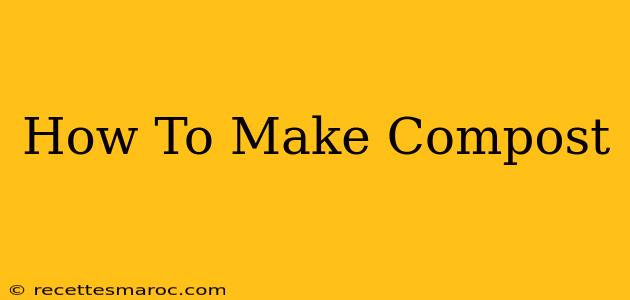Composting is a fantastic way to recycle kitchen and yard waste, creating nutrient-rich soil for your garden. It's environmentally friendly, saves you money on store-bought fertilizers, and reduces landfill waste. This guide will walk you through the process, from choosing the right materials to maintaining your compost pile.
Choosing Your Composting Method
There are several ways to compost, each with its own advantages:
1. The Classic Compost Pile:
This is the simplest method, involving building a pile directly on the ground. It's great for larger quantities of waste. Remember to turn the pile regularly for optimal decomposition.
- Pros: Simple, inexpensive, suitable for large volumes.
- Cons: Can attract pests, requires more space, can be messy.
2. Compost Bins:
Compost bins offer a more contained and aesthetically pleasing option. They come in various sizes and materials, from simple wooden structures to more elaborate plastic bins.
- Pros: Neater, less likely to attract pests, easier to manage.
- Cons: More expensive than a pile, might require assembly.
3. Worm Composting (Vermicomposting):
This method uses worms to break down organic matter. It's ideal for smaller spaces and produces a high-quality compost called "worm castings."
- Pros: Compact, excellent compost quality, minimal odor.
- Cons: Requires purchasing worms and a suitable bin, less suitable for large quantities of waste.
Essential Ingredients for Successful Composting:
A good compost mix requires a balance of "greens" and "browns."
Greens:
- Nitrogen-rich: Grass clippings, vegetable scraps, fruit peels, coffee grounds, tea bags. These materials break down quickly.
Browns:
- Carbon-rich: Dried leaves, shredded paper, cardboard (remove tape and labels), twigs, straw. These materials provide structure and slow down decomposition.
The ideal ratio is generally 2:1 brown to green materials.
Building Your Compost Pile or Bin:
- Location: Choose a shady spot with good drainage.
- Layering: Alternate layers of greens and browns.
- Moisture: Keep the compost moist, like a wrung-out sponge.
- Aeration: Regularly turn the pile (every few weeks) to introduce oxygen and speed up decomposition. This also helps to prevent unpleasant smells.
Troubleshooting Common Composting Problems:
Slow Decomposition:
- Insufficient moisture: Add water.
- Lack of aeration: Turn the pile more frequently.
- Too many browns: Add more greens.
Unpleasant Odors:
- Too much moisture: Add more browns and allow for better drainage.
- Lack of aeration: Turn the pile more frequently.
- Too many greens: Add more browns to balance the nitrogen levels.
Pest Infestation:
- Attractants: Remove food scraps that could attract animals.
- Barrier: Use a bin with a closed lid.
Harvesting Your Compost:
Compost is ready when it's dark brown, crumbly, and smells earthy. This can take anywhere from a few months to a year, depending on the method and conditions. You can sift out any remaining large pieces to use as mulch.
Using Your Compost:
Your finished compost is a valuable asset to your garden. Use it to:
- Improve soil structure: Compost adds organic matter, making the soil more porous and allowing for better water drainage and aeration.
- Enhance nutrient levels: It provides essential nutrients for plant growth.
- Suppress plant diseases and pests: Compost helps create a healthy soil environment.
- Retain moisture: Organic matter in the compost helps to retain soil moisture, reducing the need for frequent watering.
By following these simple steps, you can create your own nutrient-rich compost and enjoy the benefits of a healthier, more sustainable garden. Happy composting!

